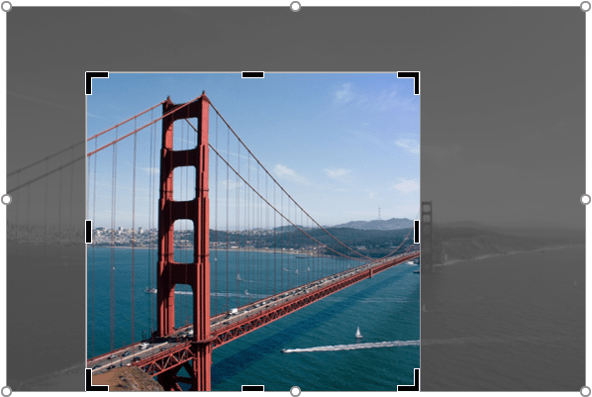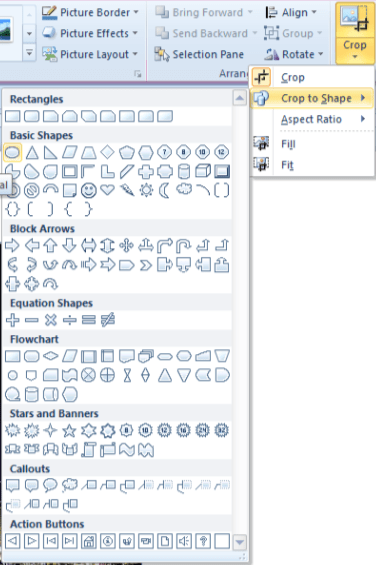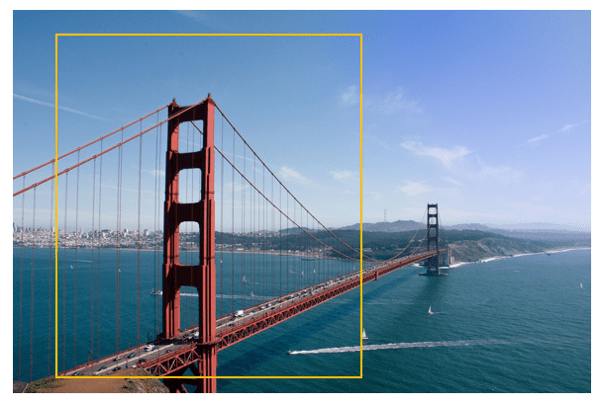Crop an Image in 4 Different Ways in PowerPoint
by Avantix Learning Team | Updated February 17, 2021
Applies to: Microsoft® PowerPoint® 2010, 2013, 2016, 2019 and 365 (Windows)
In PowerPoint, you can crop a picture in several different ways. You can apply basic cropping, crop to a shape such as an oval or triangle, crop to aspect ratio or crop to a precise size. After you have applied cropping, you can change the cropped area, adjust the position of the picture and / or resize the picture.
Note: For PowerPoint 365 subscribers, the Ribbon tabs may appear with different names depending on the size of your screen. For example, the Picture Tools Format tab may appear as Picture Format and the Drawing Tools Format tab may appear as Drawing Format or Shape Format. Buttons may also display in a different way (with or without text) depending on the size of your screen.
Recommended article: How to Compress Images in PowerPoint to Reduce File Size
Do you want to learn more about PowerPoint? Check out our virtual classroom or live classroom PowerPoint courses >
Applying basic cropping to a picture
You can apply basic cropping to a picture using Crop on the Picture Tools Format or Picture Format tab in the Ribbon:
To apply basic cropping to a picture in PowerPoint:
- In Normal View or Slide Master View, select the picture you want to crop.
- Click the Picture Tools Format or Picture Format tab in the Ribbon.
- Click Crop in the Size group. Cropping handles and sizing handles appear on the image. When the cropping and sizing handles appear, you are in crop mode. The grey areas will be cropped out of the picture.
- Position your pointer over a black cropping handle and drag the handle over the image to crop. The grey areas outside of the crop handles will be removed.
- Position your pointer over a circular sizing handle and drag if you want to resize the image. To resize the image proportionally, drag a corner resizing handle and hold down Shift as you drag.
- Point to the image (not a handle) and drag to move the image within the cropped area (if necessary).
- Click Crop in the Ribbon, click outside of the image or press ESC to finish cropping.
When you apply cropping to an image, different types of handles appear:
- The black handles that appear at the corner and sides are used for cropping the picture. Drag toward the middle of the picture to crop.
- The white circular handles can be dragged to resize the picture within the cropped area. Drag a corner handle to resize proportionally.
In the image below, note the two types of handles (the grey area would be removed when you apply cropping):
You can use the following shortcuts when cropping:
- To crop equally on two sides at the same time, hold Ctrl while you drag a side crop handle towards the middle of the image.
- To crop equally on all four sides at the same time, hold Ctrl while you drag a corner crop handle towards the middle of the image.
Cropping a picture to a shape
When you click Crop, cropping handles appear allowing you to crop to a rectangle or square. However, you may want to crop to some other shape such as an oval or triangle.
To crop a picture to a shape (such as an oval or triangle) in PowerPoint:
- In Normal View or Slide Master View, select the picture you want to crop.
- Click the Picture Tools Format or Picture Format tab in the Ribbon and in the Size group, click the arrow below Crop.
- From the drop-down menu, choose Crop to Shape and click the shape you want to use from the Shapes gallery. You can select an oval, triangle or some other shape.
- Position your pointer over a black cropping handle and drag the handle to crop (if necessary).
- Position your pointer over a circular sizing handle and drag to resize the image (if necessary). To resize the image proportionally, drag a corner resizing handle and hold down Shift as you drag.
- Point to the image (not a handle) and drag to move the image within the cropped area (if necessary).
- Click Crop in the Ribbon, click outside of the image or press ESC to exit crop mode.
In the example below, note the Shapes gallery that appears when you select Crop to Shape:
Below is a picture that has been cropped to shape:
Cropping a picture to aspect ratio
You can also crop a picture to aspect ratio or slide size. For example, in PowerPoint 2013 and later versions, the default aspect ratio is 16:9 or widescreen. When you insert an image, it may not resize to fit the screen when you drag the sizing handles. In this case, you may want to crop to aspect ratio first and then resize the image so that it fits on your slide.
To crop a picture to aspect ratio in PowerPoint:
- In Normal View or Slide Master View, select the picture you want to crop.
- Click the Picture Tools Format or Picture Format tab in the Ribbon and in the Size group, click the arrow below Crop.
- From the drop-down menu, choose Aspect Ratio and then select an aspect ratio (such as 16:9). Do not drag a cropping handle or you will lose the aspect ratio.
- Position your pointer over a circular sizing handle and drag to resize the image (if necessary). To resize the image proportionally, drag a corner resizing handle and hold down Shift as you drag.
- Point to the image (not a handle) and drag to move the image within the cropped area (if necessary).
- Click Crop in the Ribbon, click outside of the image or press ESC to exit crop mode.
If you want the picture to fill the slide, drag it to the top left of the slide and then drag the bottom right corner sizing handle to the bottom right of the slide.
Compressing pictures and deleting cropped areas
You can click Compress on the Picture Tools Format or Picture Format tab to reduce the size of one or all pictures in a presentation. In the case of cropped pictures, you can also permanently delete the cropped areas.
To compress one or more pictures in a PowerPoint presentation:
- In Normal View or Slide Master View, select the picture you want to compress.
- Click the Picture Tools Format or Picture Format tab in the Ribbon and in the Adjust group, click Compress Pictures. A dialog box appears.
- If you uncheck Apply only to this picture, all pictures in the presentation will be compressed.
- If you check Delete cropped areas of pictures, the cropped areas will be permanently deleted.
- Select the desired resolution.
- Click OK.
You will need to save the presentation, close and reopen it to see the change in file size (select the File tab in the Ribbon and then select Info to view file size in the Properties on the right side of the screen). Compressing a picture to reduce the size of the file changes the amount of detail retained in the source picture so the picture may look different after it has been compressed.
Cropping to a precise size
You may want to crop a picture to a precise size to fit into an area or frame on a slide. One way to accomplish this is to create a rectangle or shape with the precise size you want, place it over the picture and then cut the shape out of the picture.
Note: This strategy uses Merge Shapes which is available in PowerPoint 2013 and later versions.
To crop a picture to a precise size using a rectangle:
- In Normal or Slide Master View, insert a picture onto a slide.
- Click the Insert tab in the Ribbon and from the Shapes drop-down menu, select the rectangle. The pointer changes to a plus sign.
- Position the pointer on the slide and drag to draw a rectangle.
- Select the shape, click the Drawing Tools Format, Drawing Format or Shape Format tab in the Ribbon and select Shape Fill. A drop-down menu appears.
- Select No Fill from the menu. Because the shape has no fill, you'll need to select it by clicking its edge.
- With the shape selected, click the Drawing Tools Format, Drawing Format or Shape Format tab and in the Size group, enter a width and height measurement and then press Enter.
- Drag the shape (by its edge) over the area of the picture that you want to cut out. You can also use your arrow keys to move the shape.
- Click the picture first.
- Shift-click the edge of the shape.
- Click the Drawing Tools Format, Drawing Format or Shape Format tab in the Ribbon and in the Insert Shapes group, click Merge Shapes and then select Intersect from the drop-down menu.
In the following example, we selected a picture and then selected a shape on top of the picture (the order in which you select the objects is important):
Below is the final result with the shape cut out of the picture using Merge Shapes and Intersect:
When you use Merge Shapes with a picture and a shape, PowerPoint creates a new shape so you will not be able to uncrop the picture when you close and reopen the file. You can undo Merge Shapes immediately by pressing Ctrl + Z.
In this article, we've used 4 methods to crop pictures. However, there are other ways to crop. For example, you can fill a shape with a picture and then change cropping options or even convert several pictures to SmartArt to quickly crop and resize multiple images.
Subscribe to get more articles like this one
Did you find this article helpful? If you would like to receive new articles, JOIN our email list.
More Resources
How to Highlight Text in PowerPoint (5 Ways)
How to Make a Picture Transparent in PowerPoint (3 Ways)
How to Change Picture Brightness or Contrast in PowerPoint
How to Add Animation in PowerPoint (Animate Text, Images and Other Objects)
Where to Find Free Pictures for PowerPoint Presentations (10 Great Stock Image Sites)
Related courses
Microsoft PowerPoint: Intermediate / Advanced
Microsoft PowerPoint: Design for Non-Designers
Microsoft PowerPoint: Animations Bootcamp
Our instructor-led courses are delivered in virtual classroom format or at our downtown Toronto location at 18 King Street East, Suite 1400, Toronto, Ontario, Canada (some in-person classroom courses may also be delivered at an alternate downtown Toronto location). Contact us at info@avantixlearning.ca if you'd like to arrange custom instructor-led virtual classroom or onsite training on a date that's convenient for you.
Copyright 2024 Avantix® Learning
You may also like
How to Insert or Type E with an Accent Mark in PowerPoint (È, É, Ê, Ë, è, é, ê, or ë)
You can insert or type e with an accent mark in PowerPoint using built-in tools or keyboard shortcuts (including Alt code shortcuts). The letter e can be inserted with an accent in both upper or lower case in text boxes or placeholders on slides, the slide master or layouts. The following are common accents in upper or lower case – È, É, Ê, Ë, è, é, ê, or ë.
How to Fade a Picture or Part of a Picture in PowerPoint (Using a Gradient)
You can fade a picture in PowerPoint by drawing a rectangle shape on top of the picture and then filling the rectangle with a gradient from opaque to transparent. This technique is often used to fade an image into the background of a slide. Since the rectangle is placed on top of the image and then text may be placed on top of the rectangle, you may need to reorder the objects.
How to Lock an Image, Shape or Other Object in PowerPoint
You can now lock an image, shape or other object in PowerPoint. Objects can be locked in Normal View or Slide Master View. Only PowerPoint 365 users can lock objects to prevent moving and resizing. This is helpful if you want to select and move other objects on the slide or prevent others from moving or resizing an object. You can lock items using the context menu or the Selection Pane.
Microsoft, the Microsoft logo, Microsoft Office and related Microsoft applications and logos are registered trademarks of Microsoft Corporation in Canada, US and other countries. All other trademarks are the property of the registered owners.
Avantix Learning |18 King Street East, Suite 1400, Toronto, Ontario, Canada M5C 1C4 | Contact us at info@avantixlearning.ca













